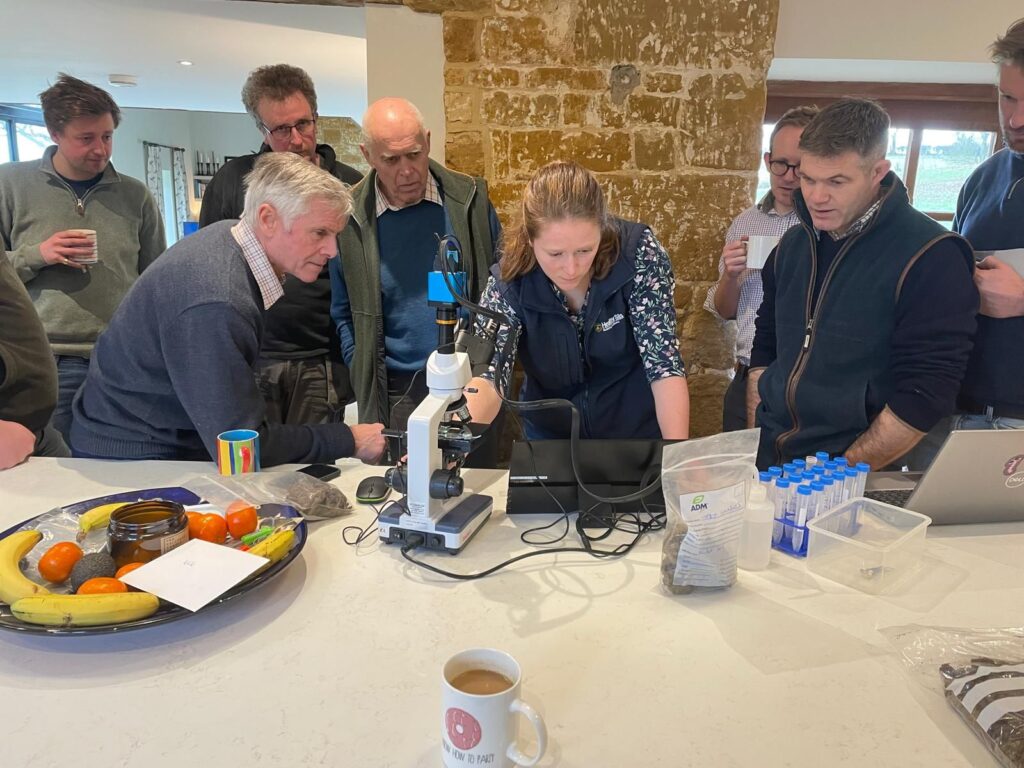Building soil biology is a win-win – Farmers Guide
Soil biology is fundamental to health, yet hard to measure and often overshadowed by physical and chemical soil properties. ...
It begins with the ‘basal’ trophic level, or the primary producers, which includes any living plant, and organic matter (crop residues, roots, etc). This is the energy source for all other biology beneath the surface, so is a crucial starting point, explains Farmacy soils specialist, Jade Prince.
There is a symbiotic relationship between plants and soil biology, where almost half of organic carbon produced by plants goes straight into the soil as root exudates, comprising sugars, amino acids and other compounds. These exudates, alongside organic matter, feed the second layer – the primary consumers – made up of bacteria and fungi.
The third layer comprises larger organisms, including protozoa, nematodes, soil mites, and springtails, which feed on the bacteria and fungi, and are key to nutrient cycling. The highest trophic level contains predatory nematodes and mites, and higher-level predators, including ground beetles, and birds.
Earthworms are often a go-to indicator of soil biology, usually grouped together within this last category, however as a generalist species, they do not easily fit into any single group, says Ms Prince.
“People often say if higher-level predators are there, then everything below that will be fine, but that’s not always the case. You can have birds, for example, without having protozoa, because the birds will eat worms. Worms do eat protozoa if they’re there, but they can also survive without them by just eating organic matter.”
Earthworms are still a great indicator of soil health, given their role in soil structure and drainage, but cannot be solely relied on for assessing soil biology.
Assessing activity
There are tests available that attempt to measure soil biology, but, lab-based testing takes time and the microbial communities can change during the sampling and sending of soil samples.
However, Hutchinsons now offers its ‘Microbe Ready Session’, whereby individuals, or groups of farmers, can learn more about soil biology and view their own soil samples through a microscope to visualise the microbial life present.
“The aim is not to measure exactly how many organisms are in a sample of soil, but to provide an insight into the types of microbes that may or may not be there,” says Ms Prince.
Images 1 (top) and 2 (bottom) highlight the clear differences between an agricultural soil with limited biology, and a sample of Johnson-Su compost extract, with far more biology present, including nematodes and protozoa.
Generally, it is best to assess soil biology when soils are warm and moist and biology is active, typically in early autumn, or spring.
Bringing biology back
One of the greatest areas of concern is in the third trophic layer of larger predatory organisms, where many agricultural soils show a notable lack of numbers, says Ms Prince.
“A lot of soils have become bacterial dominant because cultivations, and the application of synthetic fertilisers and pesticides, has, over time, suppressed numbers of fungi, protozoa and nematodes.
“Our aim is to bring soil biology back and return its role in nutrient cycling.”
There is no ‘silver bullet’ to address this, so farmers need to take a holistic approach that considers various regenerative practices, and allow time for soil biology to recover, she advises.
Composts and manures are particularly high in ‘trophic level three organisms’, such as protozoa and nematodes, so adding these to soil can help, although there are logistical challenges over large areas.
One option is to apply a Johnson-Su compost extract with seed at drilling, as this allows larger areas to be treated with a relatively small volume of compost material.
The practice is effective on all crops, and has been shown to increase rooting biomass in barley by 75%,
Ms Prince says.
“We’ve even got farmers using it on cover crop seed. If it can increase rooting in barley, the hope is it will do the same for the cover crop, and enhance the benefits it delivers to soil health.”
How long the benefits of adding soil biology last is still unclear though.
“We don’t know whether the predators we’re applying are surviving in the soil, or whether the benefits only last for that season. It seems as though applying Johnson-Su extract is something you have to do each season. By growing mono-crops, there’s simply not the variety of food needed to sustain higher levels of biology.”
Feeding soil biology with a constant, and varied, supply of organic matter, and energy from root exudates, will help support populations though, she continues.
Organic matter can be in the form of composts, manures, crop residues, or other biomass, such as from catch, cover, or companion crops. A varied rotation that maintains green, living material in the soil for as long as possible through the year is key, while bringing livestock into the rotation also helps, she adds.
